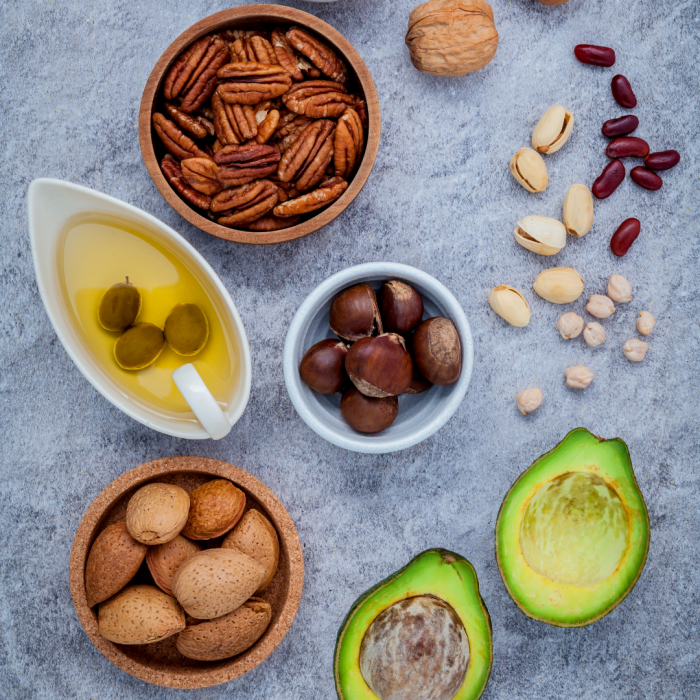The Role of Fatty Acids in our Bodies
By: Amber Whittemore RD, BSN, MHSc(c)
This week’s nutrition blog is all about healthy fats! More specifically: the fatty acids that comprise these fats in our food and the role they play in our health!
The Basics & Their Role in Our Health
The fat consumed in our diet, referred to as dietary fats, can come naturally from animal or plant foods, or be added during the cooking or processing phase. Dietary fat is essential for proper functioning, as it plays a key role in our physical and mental health as humans.
There are two main types of dietary fats: saturated and unsaturated.
The key difference between these two types of fats is the fatty acids that comprise them. Saturated fats, unsurprisingly, are made up primarily of saturated fatty acids. The structure of these fatty acids makes saturated fats solid at room temperature. In contrast, unsaturated fats are composed primarily of unsaturated fatty acids, making them liquid when at room temperature.
In general, it is recommended to choose more unsaturated fats in your day than saturated fats, since this has shown to reduce our risk of heart disease and stroke1. We will take a closer look at where we find these different types of fat below.
Looking closer at unsaturated fats, there are two different types that you may be familiar with: monounsaturated and polyunsaturated. The distinguishing factor between these is simply the length of the molecules and different bonds making them up. The two essential fatty acids for humans, omega-3 and omega-6, both belong to the polyunsaturated category. These two fatty acids are considered essential since we cannot synthesize them efficiently in our bodies, meaning we must derive them from our diet for proper functioning!
There is ample evidence to support that ensuring we are getting enough dietary fat, especially from the essential fatty acids, can help keep us out of harm’s way, by reducing certain disease risks, improving body composition, and optimizing our mental and physical performance2.
There is a myriad of specific roles that dietary fat plays in our health, such as aiding in the absorption of the fat-soluble vitamins A, D, E and K2. Being that these vitamins are fat-soluble, they require fat in our diet and gut to assist in their absorption into and transportation around the body. Adequate fat, notably from omega-3 and omega-6 fatty acids, also helps with our cell membrane health and integrity, hormone regulation, immunity, cardiovascular health, and bone density2,3! Beyond these well-established health benefits of fatty acids, there is a wealth of new knowledge supporting how omega-3 specifically is protective of our brain and mental health. If you are interested in reading more about this link, head back to our blog titled “Omega-3 and It’s Mental Health Boosting Benefits”.
Where to Find Fatty Acids

Saturated fatty acids are primarily found in red meats such as beef and pork, full-fat dairy products such as milk, yogurt, and cheese, butter, lard, shortening, palm, and coconut oils. Processed foods are also a source of saturated fat1.
Monounsaturated fatty acids are highest in peanuts, avocadoes, non-hydrogenated margarine, and oils such as olive, canola, peanut, sunflower, and safflower1.
Omega-3 polyunsaturated fatty acids can be found in flax, chia, and hemp seeds, walnuts, canola oil, and fatty fish such as salmon, herring, mackerel, and trout1.
Omega-6 polyunsaturated fatty acids are found most abundantly in vegetable oils such as soybean, sunflower, and safflower, as well as in nuts, seeds, grains and non-hydrogenated margarine1.
Being mindful of having a balanced and varied diet can help to ensure you are including sources of both saturated and unsaturated fats while emphasizing more whole foods that offer omega-3 and omega-6 fatty acids.
As a quick recap of the different sources of omega-3 fatty acids, there are three different types: ALA, EPA, and DHA. ALA is primarily found in plant foods, such as walnuts, flax, hemp, and chia seeds, soybeans, and all of the above’s oils. EPA and DHA are higher in animal foods, notably fatty fish, as well as in kelp and seaweed. Having sources of all three of these fatty acids is important for optimizing our health. You can head back to the omega-3 blog for more information on this!
How Much Do We Need?
In general, it is recommended that 20-35% of our daily calories come from fat. Therefore, the recommended intake for everyone is variable. Each gram of fat equates to 9 calories, therefore for the average person who is consuming 2000 calories, it would be recommended to eat between 45-75 grams or 400-700 calories from fat daily on average.
While the recommendation for dietary fat intake is variable, there are more specific recommendations around the essential fatty acids, omega-3 and omega-6. In our culture, it not uncommon to have ample omega-6 in our diet, while omega-3 can fall to the wayside and end up being under-consumed. When we over-consume omega-6 and under-consume omega-3 we are shifting the optimal ratio of these fats and reducing the protective effects that they can have on our health.
Research4,5 suggests that the ideal omega-6 to omega-3 ratio in our diet is between 1:1 to 4:1. Despite this, it is estimated that on average the North American diet ratio of essential fatty acids is closer to 10:1-20:14! This is likely because that processed foods have increased, elevating the amount of omega-6’s being consumed from vegetable oils. This skewed ratio is thought to be tied to the increased prevalence of inflammatory diseases such as rheumatoid arthritis, irritable bowel disease, and cancers, as well as fatty liver and cardiovascular disease4.
The best way to bring our ratio back down is to manage the number of processed foods we are eating, while also optimizing the omega-3’s in our diet. Check out the tips for increasing these fatty acids in your diet below!
Tips for Increasing Your Fatty Acids6

- Aim to include 3-4 oz of fatty fish, such as salmon, herring, mackerel, or trout, at least 2 times per week.
- If you do not eat fish, try to include seaweed or kelp into your routine to increase your EPA and DHA.
- An EPA/DHA supplement may be recommended if you are unable to consume fatty fish as outlined, if this is the case the general guideline is to obtain one with 500 mg EPA and DHA combined7.
- Optimize your meals with omega-3 fatty acids by opting for flaxseed, walnut, or canola oil for cooking or salad dressings.
- Include omega-3 fatty acids in your snacks, oatmeal, salads, or smoothies by adding walnuts, pecans, flax seeds, hemp hearts, and/or chia seeds.
- If you eat eggs, choose omega-3 fortified to boost your fatty acids in the morning or baking.
The Bottom Line
Dietary fat is an essential component of our health as humans, we need to it properly absorb and utilize many of our nutrients and for proper mental and physical functioning. While all fats, saturated and unsaturated, play an important role in the provision of energy and proper bodily functions, the fats that have the greatest protective effect on our health are the essential fatty acids. These include the omega-3 and omega-6 fats. These essential fatty acids help to protect our heart health, immunity, bone density, and brain health. As we outlined, our culture tends to over-consume omega-6 while under-consuming omega-3, so being mindful of how to close the gap on this skewed ratio is important.
If you are looking for some recipes to help increase your omega-3 intake, these can be found in the blog “How To: Add Omega-3 into Your Diet Through Food”
If you are concerned about your fatty acid intake or have any questions you would like answered, reach out to an HEC Dietitian for guidance and support!
References
1Health Link BC. (2018, Dec). Dietary Fats and Your Health. Received from: https://www.healthlinkbc.ca/healthlinkbc-files/dietary-fats#:~:text=Dietary%20fat%20provides%20energy%2C%20and,make%20you%20feel%20full%20longer.
2Di Pasquale, Mauro. (2009). The Essentials of Essential Fatty Acids. Journal of dietary supplements. 6. 143-61. 10.1080/19390210902861841.
3National Institutes of Health. (2020, Oct 1). Omega-3 fatty acids: fact sheet for health professionals. Received from: https://ods.od.nih.gov/factsheets/Omega3FattyAcids-HealthProfessional/
4Jacob, A. (2013, Apr). Balancing Act. Received from: https://www.todaysdietitian.com/newarchives/040113p38.shtml
5Simopoulos, Artemis. (2008). The Importance of the Omega-6/Omega-3 Fatty Acid Ratio in Cardiovascular Disease and Other Chronic Diseases. Experimental biology and medicine (Maywood, N.J.). 233. 674-88. 10.3181/0711-MR-311.
6Alberta Health Services. (2016, Jan). Omega-3 Fats for Heart Health. Received from: https://www.albertahealthservices.ca/assets/info/nutrition/if-nfs-omega-3%20-fats-for-heart-health.pdf
7Global Organization for EPA and DHA (GOED) Omega-3. (2020). Intake recommendations. Received from: https://goedomega3.com/intake-recommendation
